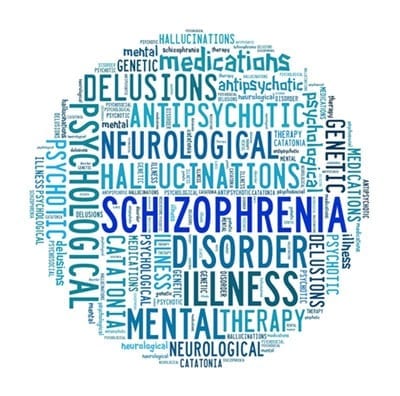
A mild zap improves cognitive control in people with schizophrenia and may lead to new therapies.
The global burden of schizophrenia is greater than that of untreated AIDS, metastatic cancer or severe dementia.
Applying mild electrical stimulation to an area of the brain associated with cognitive control helps people with schizophrenia to recognize errors and adjust their behavior to avoid them as much as it helps healthy subjects do so, according to a new study by Vanderbilt psychologists. The research was published June 29 in the Proceedings of the National Academy of Sciences.
One of the core symptoms of schizophrenia is poor cognitive control—a constellation of abilities including working memory, attention, focus and error-monitoring. Error-monitoring can be measured by “post-error slowing”—the almost imperceptible pause healthy people take after committing a mistake, like making a typo, in order to avoid doing it again. “It has been known for decades that error-monitoring is reduced in individuals with schizophrenia,” said Sohee Park, Gertrude Conaway Vanderbilt Professor of Psychology, who contributed to the research. “This impairment has been extremely difficult to remediate.”
An important brain area involved in cognitive control is the medial frontal cortex. In previous research, lead author Robert Reinhart, a graduate student in psychology, was able to improve post-error slowing in healthy individuals by applying a very safe, low-voltage electric current—transcranial direct stimulation, or tDCS—to the medial-frontal cortex of the brain. He wanted to see if people with schizophrenia could benefit as well.
First, participants donned EEG monitors and performed a challenging cognitive control task specifically designed to trip them up. “We saw a beautiful burst of low-frequency activity [from the medial-frontal cortex] right after someone made a mistake,” said Reinhart. “But it was deficient in our patients with schizophrenia.”
In healthy individuals, these theta waves were steady and synchronized, but in people with schizophrenia, the waves were weak and disorganized, suggesting that they were having a harder time processing the mistake. And the subjects’ behavior bore that out—the healthy subjects slowed down by a few milliseconds when they made mistakes and did better in the next round, while the subjects with schizophrenia did not.
After tDCS, the picture was dramatically different. The electrical stimulation to the scalp significantly improved the strength and synchrony of the brain waves in both groups but most notably in people with schizophrenia. “The results of our study clearly indicate that it is possible to restore error-monitoring in people with schizophrenia with tDCS,” said Park.
In addition to measuring post-error slowing, the researchers measured how well the medial-frontal cortex communicated with another region of the frontal lobe called the lateral prefrontal cortex, which is also believed to play a role in adaptive control. Reinhart and his co-investigators found that this connection was abnormally reduced in people with schizophrenia compared to healthy people, but that again, stimulation improved the connection between the two regions equally well for both groups. This was another important finding, because it strongly suggests that this particular symptom of schizophrenia is not due to a categorical difference in the brain. Rather, it suggests that the schizophrenic brain is doing what a healthy brain does—it’s just not doing it as well.
Read more: A little jolt helps the brain get back on track
The Latest on: Schizophrenia
[google_news title=”” keyword=”schizophrenia” num_posts=”10″ blurb_length=”0″ show_thumb=”left”]
via Google News
The Latest on: Schizophrenia
- Freedom no therapy in schizophrenia’s black holeon April 26, 2024 at 4:29 pm
On an unseasonably warm late April night, candles flicker in the dark on the grassy slopes that frame Sydney’s Bondi Beach. Hundreds of locals sit quietly on the ground, many weeping, still ...
- Cat exposure during early life could double schizophrenia risk, meta-analysis suggestson April 24, 2024 at 11:00 am
Owning cats during early life may more than double the risk of developing schizophrenia-related disorders in young adulthood, though the impact on milder psychotic-like experiences remains unclear.
- Treatment Patch For Schizophrenia: Newly Listed Alto Neuroscience Is Uniquely Positioned In Neuropsychiatry Landscapeon April 23, 2024 at 12:05 pm
Alto Neuroscience reported positive results for its novel PDE4 inhibitor in a Phase 1 study for cognitive impairment associated with schizophrenia.
- Breathtaking News for Depression and Schizophreniaon April 23, 2024 at 8:19 am
As long as there's breath in our lungs our story is still being written.” –Bart Millard Two chemicals from breath samples, butyrate and trimethylamine, are sufficient to distinguish depression and ...
- Physical Ills Often Plague People With Schizophrenia, Bipolaron April 23, 2024 at 5:18 am
Estimates show people with schizophrenia or bipolar disorder are 2.4 times more likely than mentally healthy people to have two or more physical ailments, researchers found. The chronic disease burden ...
- Schizophrenia Causes: Genetics, Environment, and Moreon April 19, 2024 at 4:59 pm
Doctors don’t know for sure what causes schizophrenia. Research shows a combination of genetics and your environment can trigger the disease. If you have a family member with schizophrenia ...
- Schizophrenia Prodromeon April 18, 2024 at 5:00 pm
About 75% of people with schizophrenia go through a prodrome phase. It may last a few weeks, but for some people, these signs slowly worsen over several years. You may notice changes in yourself ...
- Having a Cat Can Double Your Chances of Developing Schizophrenia, New Study Sayson April 16, 2024 at 4:06 pm
In a new study, scientists found that those who owned cats before age 25 were about twice as likely to develop schizophrenia.
- What Are The Possible Complications Of Schizophrenia? A Review By Doctorson April 16, 2024 at 2:28 pm
Expert opinion from Ilya Aleksandrovskiy M.D., MBA · 5 years of experience · USA Schizophrenic patients either exhibit substance abuse or develop schizophrenia due to it. Therefore, substance abuse is ...
- Parents of Sydney mall killer Joel Cauchi say he was off his schizophrenia medication: ‘He let himself down’on April 15, 2024 at 1:48 pm
Sydney shopping mall killer Joel Cauchi’s father said his son was a “beautiful” boy, who “let himself down” when he went off his medication.
via Bing News




